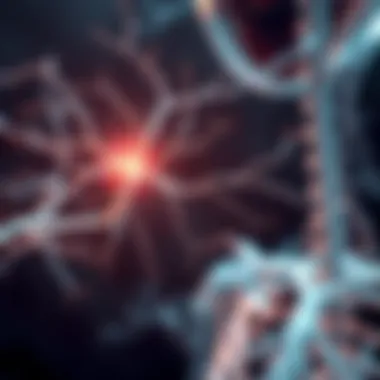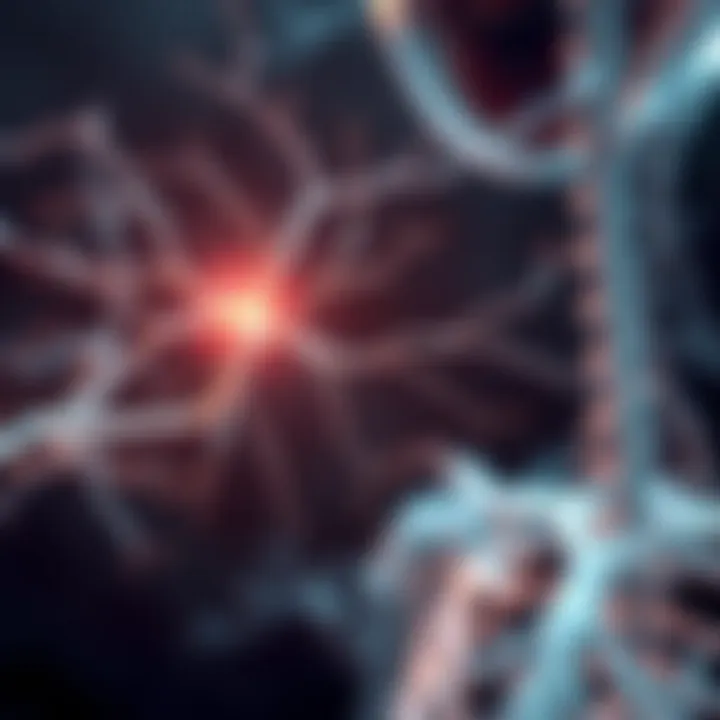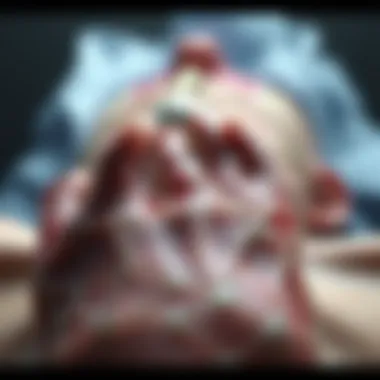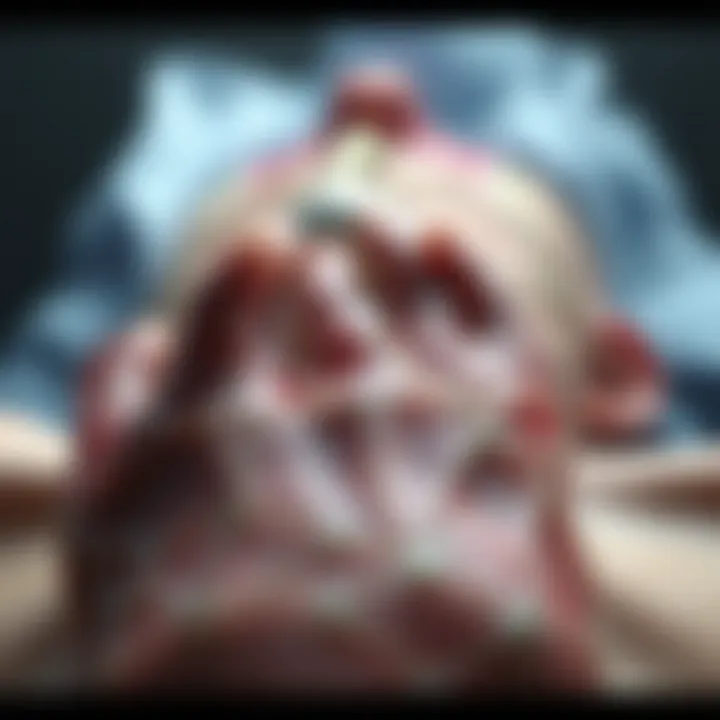Understanding the Stages of Guillain-Barré Syndrome


Intro
Guillain-Barré Syndrome (GBS) is a perplexing condition that often springs up unexpectedly, catching many off guard. Imagine waking up one day feeling perfectly fine, only to find that subtle weakness in your legs is the first sign of a much larger issue. GBS is primarily characterized by the sudden onset of muscle weakness, which can escalate rapidly, leading to paralysis. Understanding this syndrome isn't just crucial for medical professionals; it's vital for anyone touched by its effects, be it patient, family member, or caregiver.
In this guide, we A, B, C will untangle the complexities of GBS, tracing its journey from initial signs to the recovery phase. This is a critical exploration that aims to inform not just the diagnosis and treatment options available but also the long-term implications of living with GBS. By weaving together insights from current research and clinical practices, readers will gain a robust understanding of not only the symptoms but also the emotional and physical toll this syndrome can take.
The nuances of GBS are what make it both fascinating and frustrating. As we move through the stages of this syndrome, we'll highlight the key points and provide clarity on why these elements matter. Whether you’re a student, researcher, healthcare provider, or someone looking to understand GBS better, this narrative is meant to serve as a foundational resource.
Key Concepts and Terminology
Definition of Key Terms
Understanding the terminology surrounding GBS is essential for meaningful engagement with the subject. Here are some key terms you should know:
- Acute: Referring to a sudden onset of symptoms. In the case of GBS, symptoms can develop over days to weeks.
- Paralysis: A condition characterized by the loss of muscle function in one or more muscles. GBS often results in varying degrees of paralysis.
- Autoimmune Disorder: A condition where the immune system mistakenly attacks the body’s own tissues. GBS fits this category, as it often follows an infection.
Concepts Explored in the Article
This guide will delve into several important concepts related to GBS:
- The stages and progression of Guillain-Barré Syndrome, examining each phase with precision.
- The role of the immune system and how it interacts with neural pathways during the course of the syndrome.
- Diagnostic processes—what medical professionals look for and the tests commonly employed.
- Various treatment options and their efficacy in managing symptoms and aiding recovery.
- The long-term prognosis of those affected and factors that may influence recovery.
"Grasping the early signs of GBS could be the difference between a swift recovery and a prolonged challenge."
Findings and Discussion
Main Findings
Throughout our research, several key discoveries surrounding GBS have emerged:
- Early Diagnosis is Critical: The sooner a diagnosis is made, the quicker treatment can start, which potentially leads to better outcomes.
- Individual Variation in Symptoms: There isn’t a one-size-fits-all presentation of GBS. Some individuals may experience mild symptoms, while others may see severe consequences.
- Rehabilitation is Essential: Post-acute recovery often requires extensive rehabilitation to regain muscle strength and function.
Potential Areas for Future Research
The landscape of GBS is continually evolving, and there are pressing areas for further investigation:
- The exact mechanisms by which GBS interacts with the immune system remain unclear and merit deeper exploration.
- Longitudinal studies on the long-term effects of GBS can help shape the strategies for management and care.
- Alternative treatment approaches, including the role of newer immunotherapies, should be researched to refine treatment protocols.
Understanding Guillain-Barré Syndrome is more important now than ever as awareness grows and research advances. This comprehensive guide aims to shed much-needed light on the various stages and critical points of this syndrome, offering insights and knowledge that may aid in addressing the complexities of GBS.
Understanding Guillain-Barré Syndrome
Understanding Guillain-Barré Syndrome (GBS) is crucial, as it allows individuals and healthcare providers to navigate this rare yet serious neurological condition. GBS can affect a range of patients, and its impact often extends beyond the physical symptoms to emotional and psychological layers. That's why an in-depth exploration is necessary, framing this condition not just in medical terms but also in real-life experiences.
This section seeks to break down GBS into manageable pieces. We'll discuss not only what the syndrome is but also the statistics surrounding it. Recognizing the epidemiology helps to contextualize the personal stories that often emerge from clinical case studies. Further, an insight into the pathophysiology provides a foundational understanding of how GBS manifests, allowing readers to grasp the complexities involved in diagnosing and treating it.
The benefits of understanding GBS are significant. For students, researchers, and healthcare professionals, this clarity can lead to more effective patient interactions and improved treatment protocols. Even those with loved ones affected by GBS can gain a clearer perspective, arming them with knowledge that helps them support their relatives during a challenging time. Thus, our focus on the importance of understanding Guillain-Barré Syndrome aims not only to inform but also to empower.
Definition and Overview of GBS
Guillain-Barré Syndrome is an autoimmunological disorder characterized by a rapid onset of muscle weakness and paralysis. Its precise cause remains uncertain, but it often follows an infection or an immune response. Typically, patients experience symptoms like tingling and weakness, which can escalate to significant mobility challenges, sometimes leading to life-threatening complications.
As a result, GBS can be a daunting diagnosis, leaving many patients and their families grappling with fear and uncertainty. Raising awareness and understanding about the syndrome can demystify the condition and foster a sense of agency in those facing it.
Epidemiology of Guillain-Barré Syndrome
The epidemiology of GBS grants insight into its frequency and demographic characteristics. Globally, GBS affects approximately one in 100,000 people, with variations based on geographic location, age, and gender. More specifically, it tends to be slightly more prevalent in males than females, an aspect that has puzzled researchers.
Understanding the epidemiological landscape is vital for healthcare providers. Observing patterns can help in early detection and potential interventions. For instance, GBS often has a peak incidence in adults aged 30 to 50, but it can appear in younger individuals and even in children.
Key Takeaways:
- Incidence: 1 in 100,000 people
- Demographic Trends: Slight male predominance, peak incidence in middle age
- Geographic Variability: Different rates in varying regions
In summary, the epidemiology of GBS is not just numbers; it’s about real people. By grasping these trends, we create a foundation for enhanced clinical vigilance and a proactive stance toward understanding this complicated condition.
Pathophysiology of GBS
The pathophysiology of Guillain-Barré Syndrome hinges on the immune system erroneously attacking the peripheral nerves. Often, this is triggered by prior infections, with campylobacter jejuni being a frequently mentioned culprit. The immune response mistakenly identifies nerve tissue as a target.


This autoimmune attack leads to demyelination—essentially stripping the protective covering from the nerves. Without this insulation, communication between nerves and the nervous system becomes disrupted, resulting in symptoms like weakness, sensory loss, and in some cases, complete paralysis.
Initial Stage of Guillain-Barré Syndrome
The initial stage of Guillain-Barré Syndrome (GBS) is a critical period that acts as a precursor to both diagnosis and treatment. Identifying and understanding this early phase not only aids healthcare professionals but also helps patients and their families prepare for the journey ahead. Recognizing symptoms promptly can lead to timely interventions, potentially improving long-term outcomes. This stage is marked by the emergence of various neurological symptoms, which vary from person to person. Early detection in this phase can make a world of difference, allowing for closer monitoring and prompt medical exploration.
Common Early Symptoms
In this stage, patients often experience a range of symptoms that are subtle and can be easily overlooked. Here are a few common signals that might indicate the onset of GBS:
- Weakness: A noticeable weakness in the legs that traditionally escalates upwards, affecting mobility and daily activities.
- Tingling or Numbness: Patients may describe feelings akin to “pins and needles” in hands or feet, which can be quite uncomfortable.
- Changes in Sensation: A loss of sensitivity to touch or pressure might be reported, suggesting early involvement of the peripheral nerves. This may lead individuals to feel disconnected from their own bodies.
- Muscle Pain: Some people might experience muscle aches that seem to arise from nowhere, making it hard to identify the cause.
- Fatigue: An overwhelming sense of tiredness that may not correlate with physical exertion often accompanies these symptoms.
These symptoms are essential for identifying the underlying issues around GBS. It’s important to keep in mind that not every case will present with all of these hints, making personalized assessments vital.
Diagnosis at the Onset
Timely diagnosis plays a crucial role during the initial stage. The detection process typically involves a thorough patient history and physical examination. Neurologists often opt for specific tests to confirm suspicions of GBS:
- Lumbar Puncture: This procedure analyzes the cerebrospinal fluid, revealing elevated protein levels, which is a typical finding in Gullain-Barré patients.
- Electromyography (EMG): By measuring the electrical activity in muscles, physicians can evaluate the functionality and responses of nerves.
- Nerve Conduction Studies: These tests assess the speed at which electrical impulses pass through the nerves, pinpointing any abnormalities.
In addition to these tests, physicians might rely on patients’ descriptions of early symptoms to piece together the puzzle.
"Recognizing the importance of early diagnosis in Guillain-Barré Syndrome greatly influences treatment success and overall patient outcomes."
As patients navigate this initial phase, it’s essential to maintain open communication with healthcare providers. Support systems, both emotional and informational, are invaluable in preparing to handle the changes ahead. Understanding the symptoms and pursuing swift diagnosis not only demystifies GBS but could ultimately steer the course toward a better recovery.
Acute Stage of Guillain-Barré Syndrome
The acute stage of Guillain-Barré Syndrome (GBS) marks a critical phase in the progression of this neurological disorder. Understanding this stage is vital, not just for medical professionals, but also for patients and their families. This period is defined by a rapid escalation in symptoms, which can lead to severe complications if not monitored and managed appropriately. Knowing what to expect during this time allows patients and caregivers to be better prepared, facilitating effective communication with healthcare providers and swift action when necessary.
Progression of Symptoms
In GBS, the acute stage typically manifests with a rapid progression of neurological symptoms. Initially, individuals may experience tingling sensations or weakness in the legs, which can swiftly extend to the arms and respiratory muscles. This spreading weakness can feel like a creeping wave, leaving many feeling completely overrun.
Some key characteristics of symptom progression include:
- Symmetry: The weakness usually affects both sides of the body equally, which can be a critical differentiator from other neurological conditions.
- Bilateral Weakness: The weakness can escalate to profound flaccid paralysis in some cases.
- Severity Variation: While some individuals may maintain minimal symptoms, others could face significant challenges, including difficulties in breathing, which directly impacts their oxygen supply and can lead to life-threatening situations.
It’s important for those affected by GBS to keep a close watch during this stage, as recognizing the expeditious nature of symptom development can be crucial for timely intervention.
Neurological Assessment Findings
Healthcare professionals employ various techniques during the acute stage to assess the progression and severity of GBS. Neurological assessments become indispensable tools for understanding how the disease is advancing. These evaluations commonly include:
- Reflex Testing: In GBS, deep tendon reflexes are often diminished or absent. This can provide significant insight into the degree of neurological impact.
- Electromyography (EMG): An EMG can help gauge the electrical activity in muscles, showing slowed nerve conduction velocities, which can confirm a diagnosis of GBS.
- Lumbar Puncture: Analyzing cerebrospinal fluid (CSF) may reveal an elevated protein level with a normal white blood cell count, a classic indicator of GBS, often referred to as albuminocytologic dissociation.
These findings enable physicians to determine the extent of nerve damage and refine their treatment plans. Understanding these assessments can provide assurance to patients and families as they navigate this challenging trajectory.
Management of Acute Symptoms
Managing symptoms in the acute stage is critical for improving patient outcomes and preventing complications. A multi-faceted approach is typically adopted, focusing on symptomatic relief and maintaining vital functions. Some management strategies include:
- Intravenous Immunoglobulin (IVIG): This treatment is often the first line for individuals with moderate to severe symptoms, helping to reduce the body's immune response that attacks the nerves.
- Plasmapheresis: In cases where IVIG is not suitable, plasmapheresis can be employed to filter harmful antibodies from the blood, aiding in recovery.
- Physical Therapy: Early intervention with physical therapy can help maintain muscle strength and prevent contractures, promoting mobility throughout recovery.
Effective treatment during the acute stage significantly influences long-term recovery outcomes for individuals with Guillain-Barré Syndrome.
In summary, the acute stage of GBS is a pivotal moment that requires vigilant attention and prompt medical care. By recognizing the signs and symptoms of this stage, healthcare teams can devise appropriate management strategies. Thus, fostering hope and guiding patients and their families through what may seem like uncharted waters.
Plateau Stage of Guillain-Barré Syndrome
The plateau stage of Guillain-Barré Syndrome (GBS) marks a pivotal point in the disorder's progression. During this phase, the patient experiences a stabilization of symptoms following a period of acute progression. This stage often brings a sense of relief as the relentless worsening of neurological deficits seems to halt. However, this stabilization comes with its own set of challenges and considerations.
The importance of recognizing the plateau stage lies not just in patient management but also in informing the family and caretakers about expectations. Understanding that symptoms are stabilized allows for focused rehabilitation planning. It is in this stage where multidisciplinary teams can chart an effective path forward.
Moreover, monitoring the patient's condition during stabilization is crucial. Although symptoms might not be getting worse, vigilance is key to identify any potential complications that could arise.
Stabilization of Symptoms
In the plateau stage, patients may find that their symptoms remain unchanged over time. This could manifest as a consistent level of weakness, sensory loss, or pain. While some might interpret this stagnation positively, it is essential to grasp that stabilization does not imply recovery. For instance, a patient who has lost most motor function might not improve immediately, and understanding that is vital for both the patient and family.


- Physical Limitations: Understanding a patient's limitations becomes an important aspect of rehabilitation during stabilization. Daily activities require adaptation and patience.
- Psychological Support: The mental toll of dealing with a chronic condition cannot be understated. Support systems and counseling may become crucial at this stage.
- Rehabilitation Goals: Setting realistic goals tailored to individual circumstances encourages motivation. Trained therapists can initiate light physical activity aimed at preserving muscle function, which is instrumental in later recovery.
Continuous Monitoring Strategies
Any medical professional will emphasize that continuous monitoring is indispensable during the plateau phase. While improvement may not be evident immediately, keeping a close eye on the patient's overall health can prevent potential setbacks. Strategies may include:
- Regular Neurological Assessments: Scheduled evaluations can help in tracking subtle changes in neurological status, which might indicate complications emerging.
- Vitals Monitoring: Close monitoring of blood pressure, heart rate, and respiratory function should be second nature in GBS management a this stage.
- Family Education: Families of patients are often in need of guidance on what signs to watch for, reassessing their loved one's condition regularly can foster a proactive approach to any emerging issues.
"Knowledge is power: during the plateau stage, informed families can play an active role in patient care."
For more resources on GBS, consider visiting CDC - Guillain-Barré Syndrome or explore articles on PubMed.
Understanding GBS requires patient involvement in their recovery journey, as well as continued research to improve outcomes for those affected.
Recovery Stage of Guillain-Barré Syndrome
The recovery stage of Guillain-Barré Syndrome (GBS) marks a significant turning point in the journey of affected individuals. Understanding this stage is crucial, as it lays the groundwork for both physical healing and psychological well-being. Recovery is not merely an instinctual reversal of symptoms but a complex process involving various factors that can influence outcomes.
Emphasizing the importance of this stage, we must remember that not every patient experiences recovery in the same way. Factors such as age, initial symptom severity, and underlying health conditions all come into play. This makes recognizing potential variations in recovery crucial for patients and caregivers alike. It's not just about regaining physical capabilities; the psychological aspect is undeniably integral to holistic recovery.
"The road to recovery may be long, but with the right strategy and support, individuals can navigate it with resilience."
Potential for Recovery
Evaluating the potential for recovery in GBS speaks to the heart of patient hope and clinician expectations. Generally speaking, many individuals diagnosed with GBS will see improvements within weeks to months. However, it’s critical to underscore that some may continue to experience residual effects for years, while others may recover completely. Factors influencing this potential include the type of GBS diagnosed, the patient’s overall health status prior to onset, and the speed and effectiveness of initially administered treatments.
Early interventions, such as plasma exchange or immunoglobulin therapy, have shown to enhance recovery potential. Additionally, each patient's unique context plays a pivotal role—what works for one individual may not hold for another. Communication between healthcare professionals and patients is key to setting realistic expectations and promoting an optimistic outlook where feasible.
Rehabilitation Approaches
Rehabilitation is a cornerstone of recovery from GBS, encompassing a multifaceted approach tailored to individual needs. Early mobility is encouraged, but it must be approached cautiously to avoid fatigue. Here are some rehabilitation strategies often employed:
- Physical Therapy: This might include tailored exercises aimed at rebuilding strength, coordination, and flexibility.
- Occupational Therapy: Helping individuals regain the ability to perform daily activities and improve overall independence.
- Speech Therapy: For those experiencing difficulties in swallowing or communication, speech therapy can play a crucial role in restoration.
Rehabilitation should be personalized and adaptable, taking into account the patient's progress and ongoing challenges. It is not merely about moving from one exercise to another; it requires constant assessment and modification to fit individual recovery trajectories.
Long-Term Outcomes
Long-term outcomes after recovery from Guillain-Barré Syndrome can vary widely among individuals. While many patients do achieve significant improvements in mobility and daily living functions, some may face challenges that persist long after the onset has passed. The most common long-term effects can include:
- Fatigue: A pervasive issue that affects daily living.
- Sensory Changes: Tingling, numbness, or pain may linger, impacting quality of life.
- Emotional Effects: Anxiety or depression can arise after experiencing such a traumatic health event.
Understanding these long-term implications is essential for both patients and healthcare providers. It creates an opportunity for ongoing support, establishing a proactive framework for managing chronic symptoms and improving the overall quality of life. The journey may be rocky, but awareness and education can pave smoother pathways for recovery and adaptation.
For further insights and research, resources like Wikipedia, Britannica, and NIH can provide valuable information on GBS.
Factors Influencing Recovery from Guillain-Barré Syndrome
Understanding the factors that influence recovery from Guillain-Barré Syndrome (GBS) is crucial in piecing together the trajectory of this condition. Recovery can vary widely from one individual to another, often influenced by a multitude of factors. This section delves into key elements such as age, gender, and underlying health conditions that may affect a patient's rehabilitation process and overall prognosis.
The recovery phase is not simply about getting back to what was once normal; it involves comprehending how various aspects of a patient’s life can impact healing. Among these, age and gender stand out as prominent contributors. Additionally, any pre-existing health conditions can play a significant role in how effectively one rebounds from GBS. Emphasizing these factors can help patients and caregivers make informed decisions regarding treatment and ongoing care, ultimately highlighting the importance of personalized approaches.
Age and Gender Considerations
Age is a critical determinant in understanding the recovery landscape of GBS. Older adults often face a tougher uphill battle, with research indicating that individuals above the age of 50 may experience a slower recovery timeline and greater disability after the acute phase of GBS has passed. This phenomenon could be attributed to several factors, including a generally reduced regenerative capability of nerves in older populations. Younger patients tend to bounce back more swiftly, often experiencing less severe symptoms and a shorter duration of illness.
Gender also plays a role in recovery outcomes. Studies suggest that females may experience different severities and manifestations of the syndrome compared to males. This difference may influence treatment responses, with some data indicating that women might have better long-term outcomes when compared to men. Such nuances underscore the need for tailored recovery strategies that account for age and gender differences.
- Women tend to recover faster than men.
- Older patients may suffer prolonged recovery.
- Individual experience varies, calling for personalized treatment plans.
Underlying Health Conditions
Underlying health conditions can reshape recovery trajectories significantly. Patients with previous neurological issues, autoimmune disorders, or chronic illnesses may find their recovery more complicated. Such conditions could predispose individuals to a more severe acute phase or lead to longer-lasting symptoms post-recovery.
Comorbidities have been established as an important consideration during treatment planning. For instance, someone with diabetes might have issues with nerve repair or healing times due to fluctuating blood sugars. Similarly, cardiovascular problems might complicate rehabilitation exercises and overall physical recovery efforts.
"Recovery from Guillain-Barré Syndrome is not merely a matter of time, but rather an intricate interplay of various personal health factors. Recognizing these can profoundly affect treatment approaches."
Factors that impact recovery include but are not limited to:


- Autoimmune diseases
- Chronic respiratory problems
- Diabetes and metabolic syndrome
Being cognizant of these conditions allows healthcare providers to craft more effective rehabilitation strategies, thereby enhancing the chances for a favorable outcome. Furthermore, it empowers patients and their families to engage more meaningfully in recovery discussions with their medical teams, aligning personal health histories with proposed treatment paths.
In summary, acknowledging the influencing factors such as age, gender, and underlying health conditions offers a richer understanding of recovery from Guillain-Barré Syndrome. Through this comprehensive lens, the pathways toward rehabilitation can be better navigated, improving outcomes and quality of life for those affected.
Complications Associated with Guillain-Barré Syndrome
Complications from Guillain-Barré Syndrome (GBS) warrant careful examination due to their potential impact on patient health and quality of life. Understanding these possible complications helps healthcare providers design effective management strategies, and it also equips patients and their families with necessary foresight. Complications can not only prolong recovery but may also lead to serious, sometimes permanent disability. Addressing these complications ensures comprehensive care for individuals affected by GBS.
Potential Severe Outcomes
The outcomes of complications associated with Guillain-Barré Syndrome can be quite severe, ranging from paralysis to life-threatening respiratory failure. A few critical outcomes include:
- Respiratory Failure: Many patients experience respiratory muscle weakness as GBS progresses, which can necessitate mechanical ventilation. This outcome underscores the importance of monitoring lung function closely.
- Autonomic Dysfunction: Changes in heart rate, blood pressure, and bowel or bladder control can occur due to the nervous system's involvement, sometimes leading to crises that require urgent intervention.
- Deep Vein Thrombosis (DVT): With decreased mobility, GBS patients are at a heightened risk for DVT, which can lead to further complications, including pulmonary embolism.
- Chronic Pain Syndromes: Some patients suffer from ongoing neuropathic pain even after other symptoms have improved, impacting their long-term quality of life.
"While Guillain-Barré Syndrome often presents with manageable symptoms, the gravity of potential complications should not be underestimated."
These outcomes highlight the necessity for ongoing assessment and prompt alignments to treatment plans as patient symptoms evolve.
Management of Complications
Efficient management strategies for the complications arising from GBS involve a multidisciplinary approach tailored to the unique needs of each patient. Here are some vital management strategies:
- Respiratory Monitoring: Regular assessment of pulse oximetry and respiratory function tests can help detect weakness early, allowing for timely interventions like non-invasive ventilation or tracheostomy if warranted.
- Physical Therapy: Early mobilization may be encouraged to prevent complications like DVT and enhance circulation. Regular physiotherapy sessions can also help with recovering muscle strength and coordination.
- Pain Management: Addressing chronic pain effectively is crucial. Utilization of medications like gabapentin or neuropathic pain therapies can provide relief, while psychological support may further assist in coping strategies.
- Support for Autonomic Dysfunction: Medications to stabilize blood pressure and manage heart rate may be necessary. Additionally, daily monitoring can aid in detecting autonomic crises before they become critical.
- Patient and Family Education: Providing thorough information regarding potential complications and their signs can empower patients and families to seek timely medical attention when needed.
The End on the Stages of Guillain-Barré Syndrome
The complexity of Guillain-Barré Syndrome (GBS) makes understanding its stages vital for both medical professionals and those affected by the condition. This discussion wraps up our exploration by highlighting key insights and considerations regarding GBS.
Firstly, recognizing the stages of GBS—from initial symptoms to recovery—provides a framework for better diagnosis and management. Each stage presents distinct characteristics and challenges that can influence treatment pathways.
It’s crucial for healthcare providers to grasp the nuances of GBS, as timely interventions can significantly impact patient outcomes. Knowledge of the stages means that symptoms can be identified more readily, allowing for appropriate management before complications arise.
Moreover, this structured understanding empowers patients and their families. By comprehending what to expect at each stage of the illness, they can approach the healthcare process with clearer expectations and enhanced engagement. This can be comforting, as the unknown often adds anxiety to an already distressing situation.
In addition, recognizing the various factors that might affect recovery, such as age and underlying health conditions, lends depth to the broader narrative of GBS. This awareness can guide personalized treatment plans that cater to individual patient needs, thereby maximizing recovery potential.
Ultimately, a thorough grasp of the stages of Guillain-Barré Syndrome fosters a proactive approach to management, improving the overall experience for patients and supporting significant strides in rehabilitation outcomes. It is a prime example of how understanding disease dynamics can lead to more effective care strategies, enhancing both life quality and recovery prospects.
Summative Insights
In reviewing the contents of this article, we see several pivotal insights emerge:
- Early Recognition: Identifying the initial symptoms early can facilitate quicker diagnosis, which is crucial for effective treatment.
- Rehabilitation Significance: The recovery stage is essential not just for regaining mobility but also for addressing emotional and psychological well-being.
- Patient Empowerment: Educating patients about their condition can promote active involvement in their care, ultimately contributing to better outcomes.
- Interdisciplinary Care: Collaboration among healthcare providers—neurologists, physiotherapists, occupational therapists—is vital in managing the syndrome comprehensively.
- Research and Awareness: Continued research into GBS and raising awareness can lead to improved interventions and support for affected individuals.
Collectively, these insights not only underscore the importance of understanding each stage of GBS but also highlight the multifaceted approach needed to tackle such a complex condition. This journey through GBS illustrates the balance between patient knowledge, professional expertise, and the need for empathetic care. For further reading on Guillain-Barré Syndrome, resources from trusted platforms like National Institute of Neurological Disorders and Stroke or Mayo Clinic can provide expansive information for both patients and healthcare providers.
Integrity of Information
References serve as a foundation for understanding the complexities of GBS. They validate the information being presented and ensure that findings are grounded in peer-reviewed research rather than anecdotal evidence. This is crucial in a field that demands accuracy, especially when discussing symptoms, treatment methodologies, and outcomes.
Advancements in Understanding
Through references, one can explore how knowledge of GBS has evolved. For instance, many studies have documented the progression of symptoms and the varying recovery trajectories among patients. By analyzing these sources, medical professionals and researchers can identify patterns that might inform future cases.
Cross-disciplinary Insights
References often encompass a wide array of subjects within the medical and scientific community. From neurobiology to gastroenterology—some links have suggested infectious agents that could trigger GBS, leading to interdisciplinary dialogues that may yield new therapeutic options. That cross-pollination of ideas fosters a more holistic approach to treatment and understanding of GBS.
Standardization of Terminology
Using well-cited literature helps standardize the terminology associated with GBS. This is important not just for healthcare providers, but also for patients who seek to understand their condition. Consistent language across different studies helps in reducing confusion and facilitates better communication within the medical community.
Historical Context and Future Considerations
Examining older studies provides a historical context that can lead to further investigations. For instance, early epidemiological work may reveal how societal changes influence the incidence of GBS. Understanding these trends can guide future public health policies and educational outreach.
In sum, references are not merely footnotes on a page; they enrich the understanding of Guillain-Barré Syndrome by providing a roadmap for both past achievements and future pursuits. In an environment where every piece of information can impact lives, the integrity and depth of our references become paramount.
"Studies and papers not only inform us, they instigate future research, forming the backbone of clinical and academic advancements."
For additional reading and exploration of reliable studies, consider visiting government and educational domains such as:
- National Institute of Neurological Disorders and Stroke (NINDS)
- Centers for Disease Control and Prevention (CDC)
- Public Library of Science (PLOS)
- Clinical Trial Registry







